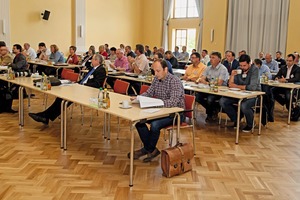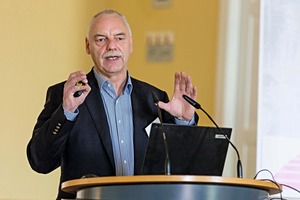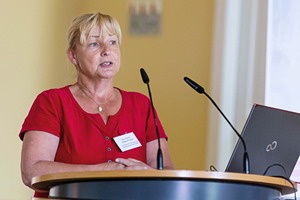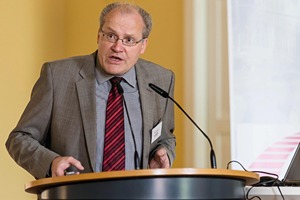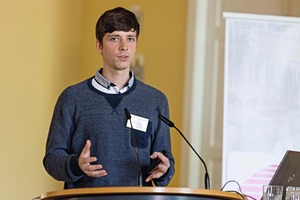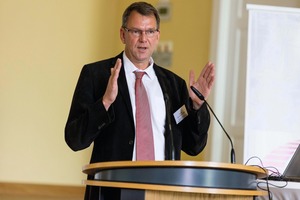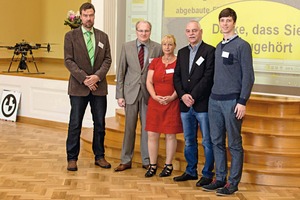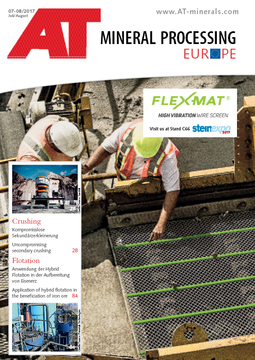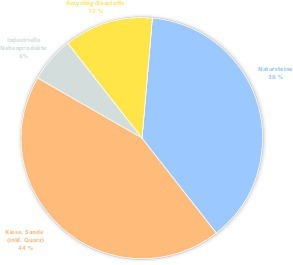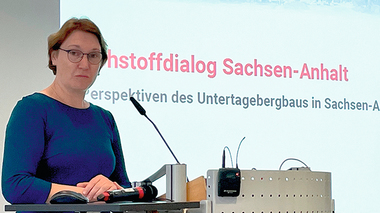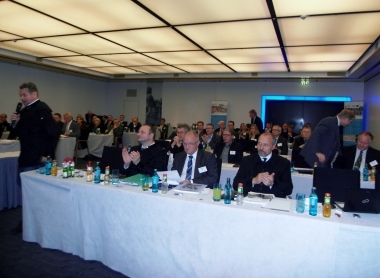16th Raw Material Colloquium in Schönebeck
“Nowadays, modern drones can be equipped with high-resolution cameras and reach flight times of up to one hour.” Rainer Hack from industry images 3d from Viereth-Trunstadt explained the numerous fields of application and the versatile analytical options of digital data, which can be seamlessly integrated into the topic of Industry 4.0. Drones can also be applied in mine surveying, mainly for topographic surveying and development of digital terrain models. “Such systems unite the advantages of airborne and terrestrial photogrammetry. They are capable of positioning themselves in each reference point in a room and can take photos without restrictions, for example, in inaccessible areas,” said Hack.
Gravelly sand, hard stones, limestone, quartz sand, lignite and natural gas are the most important raw materials in Saxony-Anhalt. In 2014, the overall production amounted to approx. 66 million tons, of which stone and earth raw materials account for about 40 million tons. “Despite these enormous amounts, raw material production exploited less than 1 % of the national territory. Currently, three of five planning regions of the German state are updating their regional planning, which is why the topic “Securing of Raw Material Supplies” is on the agenda,” as Regine Präger from the Federal State Office for Geology and Mining (LAGB) explained.
The 2010 Regional Development Plan lays an important basis for the securing of raw material supplies. In this context, first deposits of national importance have been identified as pri-ority areas, which need to be adopted by regional planning and should be complemented by further priority and restricted areas to secure the raw material supply. Regine Präger has been largely satisfied with the integration of raw material securing into the regional planning drafts of Halle and Anhalt-Bitterfeld-Wittenberg. The LAGB sees the need for a revision in the planning region of Magdeburg. Here, a constructive dialogue with the planning consortium is beeing held. Due to the enormous raw material quantities produced in Saxony-Anhalt in the past two decades, the deposit-geological knowledge flow was significantly reduced. “Since we, as the LAGB, provide the planning regions with suggestions for the designation of land and need to justify them, we have to rely on current deposit-geological data from industry,” Regine Präger appealed to the entrepreneurs.
“From our perspective, there is still a backlog regarding the long-term securing of the raw material supply independent of the requirements,” Bert Vulpius, general manager of the EAMBMI, pointed out. The State also has some nationally important gravelly sand deposits, not indicated as priority areas in the State Development Plan.” It is the task of regional planning to secure them as priority areas. This is reflected in particular by the planning region of Magdeburg. Here, each year, more than 16 million tons of stone and earth raw materials are produced. With the Flechtingen Hills, the region houses the northernmost hard stone deposits, which must provide large sections of Northern Germany with hard stone. Furthermore, the large-size gravelly sand deposits on the banks of the Elbe make a great contribution to the raw material supply of the capital region of Berlin, which, for lack of adequate deposits, is not able to meet its own demand for aggregates.
Steffen Kielwein from the Regional Planning Association Magdeburg presented the current planning status. In 2016, the Planning Association submitted the 1st draft of the Regional Development Plan Magdeburg, for which about 725 written comments were received, which are currently being processed. In order to enable a more effective evaluation process, the cooperation with the relevant companies as well as information on process states, expansion areas, exploitable areas and environmental impact assessments, complementary landscape conservation plans and FFH assessments would be desirable.
Within the course of the discussion, the implementation of the planning regarding the compatibility of raw material securing and flood protection were considered. Bert Vulpius explained that, apart from the revision of priority and restricted areas, the rules regarding distances should undergo another critical assessment as well. They should not be set out on a general basis, but should always be impact-related and case-oriented. Moreover, the environmental report on the fields of water and species protection should also be revised.
Ronald Meinecke from the Potsdam Office of Process Management and Environmental Assessments gave a lecture on the implementation of species protection and intervention ruling in the management plan process as well as on practical solutions. In this context, he went into the numerous legal foundations and requirements and highlighted the characteristics of the mining industry with regard to species protection in comparison to other industrial planning processes. In his lecture, Meinecke concluded that while mining has detrimental effects, also rare ecological and valuable habitats arise that would not have developed without mining. “Eco-accounts could make an important contribution to the fulfillment of the planning requirements of species protection and impact regulation”, said Meinecke.
The current work status of the “Mantelverordnung” - a topic industry has been dealing with for more than ten years - was presented by Dr. Berthold Schäfer of the Federal Association for Building Material, Stones and Earth (bbs) from Berlin. In future, this regulation should control the handling and exploitation of mineral construction waste and the use of recycling building materials in a uniform nationwide way. On May 3, 2017, the federal cabinet adopted the regulations, which only require the approval of the Bundestag and the Federal Council. With everything running smoothly, the adoption could be expected by September 2017. “To our great relief, the Groundwater Ordinance with its partly incomprehensible de minimis thresholds has been removed from the regulation”, Schäfer recognized the success of the associations’ work.
Despite all achievements, the regulation would lead to a stronger shift of mass flows away from the exploitation towards the disposal on landfill sites. In this context, amounts of about 35 million tons/year are predicted, which need to be disposed of in landfills, since due to the new regulation recycling is no longer possible. Therefore, Schäfer demands that, a continuous review of the regulation’s impact is to be required every two years instead of only once after four years, as provided by the Mantelverordnung. The bureaucratic documentation effort regarding the utilization of recycling construction materials, which, according to industry, is an obstacle for an effective recycling economy, is critically reviewed.

